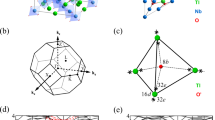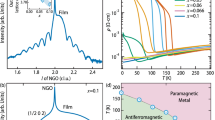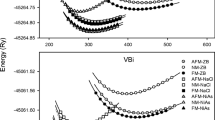Abstract
This paper discusses a possible formation mechanism of CuPt-type sublattice ordering for III-III-V type compound semiconductors by taking Ga0.5In0.5P grown on (001)GaAs as an illustrative example. The proposed mechanism relies on: (1) a particular reconstruction (‘step-terrace reconstruction (STR)’ model) on vicinal (001) surface with a misorientation towards [111]B direction, (2) a large contraction of P-P distances of P-P dimers, (3) both bond-length and bond-energy differences between Ga-P and In-P, (4) a steric effect, i.e, surface-atom position dependent atom-adsorption effect and (5) step-flow growth. These assumptions of the mechanism are examined in the light of available experimental results. Sublattice ordering in III-V-V type compounds is also briefly discussed in connection with that for III-III-V type compounds
Access this chapter
Tax calculation will be finalised at checkout
Purchases are for personal use only
Preview
Unable to display preview. Download preview PDF.
Similar content being viewed by others
References
Cao, D. S. Reihlen, E. H., Chen, G. S., Kimball, A. W., and Stringfellow, G. B. (1991), J. Cryst. Growth 109, p279
Chen, G.S., Jaw, D.H. and Stringfellow (1990), Appl. Phys. Lett. 57, p2475
Chen, G.S., Jaw, D.H. and Stringfellow, G.B. (1991), J. Appl. Phys. 69, p4263
Däweritz, L and Hey, R. (1990), Surf. Sci. 236, p15
Fuoss, P. H., Kisker, D. W., Renaud, G., Tokuda, K. L., Brennan, S. and Kahn, J. L. (1989), Phys. Rev. Lett. 63, p2389
Gomyo, A. Suzuki, T., Kobayashi, K., Kawata, S., Hino, I. and Yuasa, T. (1987), Appl. Phys. Lett. 50, p673
Gomyo, A., Suzuki, T. and Iijima, S.(1988), Phys. Rev. Lett. 60, p2645
Gomyo, A., Kawata, S., Suzuki, T., S. Iijima and Hino, I. (1989a), Jpn. J. Appl. Phys. 28, p L1728
Gomyo, A. (1989b unpublished) The disordered and ordered (Al0.6Ga0.4)0.5In0.5P layers were grown on (001)GaAs with and without Si doping consecutively under the same growth conditions (Tg:660°C, V/III:150) except doping. The NSL in the ordered layer was also CuPt type and the structure is believed to be an alternate (111)B plane alignment of (AlGa) rich plane / In rich plane / (AlGa) rich plane / In rich plane /.... The observed NSL disorder in Si doped AlGaInP possibly occurred by Si-diffusion-enhanced randomization during the growth or by a surface state change due to the doping (Suzuki (1988c)) such as disordering of 2x4 surface reconstruction (Pashley (1991b))
Gomyo, A., Suzuki, T., Kobayashi, K., Kawata, S., Hotta, H., and Hino, I. (1991), in Extended Abstracts of the 38th Spring Meeting, the Jpn Society of Applied Physics and Related Societies, Tokyo, 30a-ZG-5 (in Japanese)
Horikoshi, Y, Yamaguchi, H., Briones, F. and Kawashima, M. (1990), J. Cryst. Growth 105, p326
Ihm, Y. E., Ohtsuka, N., Klem, J. and Morkoc, H. (1987), Appl. Phys. Lett. 51, p3013
Kamiya, L., Aspnes, D. E., Tanaka, H., Florez, L. T., Harbison, J. P., and Bhat, R. (1992), Phys. Rev. Lett. 68, p627
Kobayashi, K., Hino, L., Gomyo, A., Kawata and Suzuki, T. (1987), IEEE J. Quantum Electron. QE-23, p704
Kuan, T.S., Kuech, T.F., Wang, W.I. and Wilkie, E.L. (1985), Phys. Rev. Lett. 54, p201
Kurtz, S.R., Dawson, L.R., Biefeld, R.M., Follstaedt, D.M., Doyle, B.L. (1992), Phys.Rev. B 46, p1909
Murgatroyd, I. J., Norman, A. G., Booker, G. R. and Kerr, T. M. (1986), in Imura, T., Maruse, S., and Suzuki, T. (eds.), Proc. 11th Intrn. Congr. on Electron Microscopy, Japan Soc.Electron Microscopy, Tokyo, pp1497–1498
Murgatroyd, I.J., Norman, A.G. and Booker, G.R. (1990), J. Appl. Phys. 67, p2310
Ohkouchi, S. (1991), private communication
Ogale, S.B., Madhukar, A., Joshi, S.Y. and Viswanathan, R. (1992), J. Vac. Sci. Technol. B10, p1689
Osório, R., Bernard, J. E., Froyen, S. and Zunger, A. (1992), J. Vac. Sci. Technol. B10, p1683
Pashley, M. D., Haberern, K. W. and Gaines, J. M. (1991a), Appl. Phys. Lett. 58, p406
Pashley, M.D. and Haberern, K.W. (1991b), Phys. Rev. Lett. 67, p2697
Phillips, J. C. (1973), ‘Bonds and Bands in Semiconductors’, Academic Press, New York, ch. 8
Qian G.H., Martin, R.M., Chadi, D.J. (1988), Phys. Rev. B38, p7649
Quigley, J.H., Hafich, M.J., Lee, H.Y., Stave, R.E. and Robinson, G.Y. (1989), J. Vac. Sci. Technol. B7, p358
Shahid, M. A., Mahajan, S. and Laughlin, D. E. (1987), Phys. Rev. Lett. 58, p2567
Suzuki, T., Gomyo, A. and Iijima, S. (1988a), J. Cryst. Growth 93, p396
Suzuki, T., Gomyo, A., Iijima, S., Kobayashi, K., Kawata, S., Hino, I. and Yuasa, T. (1988b), Jpn. J. Appl. Phys. 27, p2098
Suzuki, T., Gomyo, A., Hino, I., Kobayashi, K., Kawata, S. and Iijima, S. (1988c), Jpn. J. Appl. Phys. 27, p1549
Suzuki, T., Hino, I., Kobayashi, K., Gomyo, A. and Kawata, S. (1989), Optoelectronics-Devices and Technologies, 4, p317, Mita Press
Suzuki, T. and Gomyo, A. (1990), Abstracts for Sixth International Conf. on Molecular Beam Epitaxy, San Diego, USA, paper No. XII-3
Suzuki, T. and Gomyo, A. (1991a), J. Cryst. Growth 111, p353. The formation mechanism in this paper (1991a) differs from the 1988’s paper in that the previous one assumed a step height of more than 2 ML and that it did not consider surface reconstruction although it pointed out the importance of the evenness of each terrace-width. In spite of these differences, this paper (1991a) assumed SEMP-1 for the alternate alignment of Ga and In (see Section 4.3-(1) and 4.4))
Suzuki, T. and Gomyo, A. (1991b), in Extended Abstracts of the 38th Spring Meeting, the Jpn. Society of Applied Physics and Related Societies, Tokyo, 30a-ZG-6 (in Japanese)
Suzuki, T. and Gomyo, A. (1992), in A. Yoshimori, T. Shinjo and H. Watanabe (eds.), ‘Ordering at Surfaces and Interfaces’, Springer Series in Materials Science, vol 17, Springer-Verlag, Berlin, Heidelberg, pp363–375. This is the Proceedings of the Third NEC Symposium, held at Hakone, Japan, October 7–11, in 1990. In this paper, the formation mechanism of the NSL in III-V-V type compounds has also been briefly discussed
Tanimoto, M., to be published in Ultra Microscopy(1992)
Tsuda, M., Norishita, M., Oikawa, S. and Mashita, M. (1988), Jpn. J. Appl. Phys. 27, p L960
Ueda, S., Takikawa, M, Komeno, J. and Umebu, I. (1987), Jpn. J. Appl. Phys. 26, p L1824
Ueda, O., Fujii, T., Nakada, Yamada, H. and Umebu, I. (1989), J. Cryst. Growth 95, p38
Xu, C., Caffey, K. P., Burnham, J. S., Goss, S. H., Garrison, B. J. and Winograd, N. (1992), Phys. Rev. B 45, p6776
Author information
Authors and Affiliations
Editor information
Editors and Affiliations
Rights and permissions
Copyright information
© 1993 Springer Science+Business Media Dordrecht
About this chapter
Cite this chapter
Suzuki, T., Gomyo, A. (1993). Formation Mechanism of CuPt-Type Sublattice Ordering for III-III-V Type Compound Semiconductors. In: Salemink, H.W.M., Pashley, M.D. (eds) Semiconductor Interfaces at the Sub-Nanometer Scale. NATO ASI Series, vol 243. Springer, Dordrecht. https://doi.org/10.1007/978-94-011-2034-0_2
Download citation
DOI: https://doi.org/10.1007/978-94-011-2034-0_2
Publisher Name: Springer, Dordrecht
Print ISBN: 978-94-010-4900-9
Online ISBN: 978-94-011-2034-0
eBook Packages: Springer Book Archive




